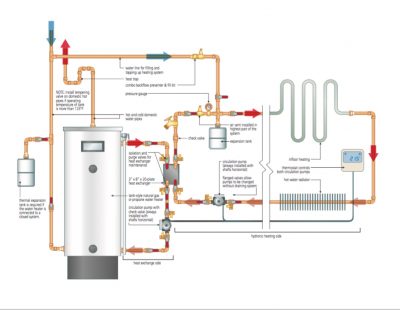Click below to watch a video tour of the two ways of connecting a tank-style water heater to infloor heating or radiators.
UPDATED 24Feb2020 + video
WHAT YOU GET IN THIS BLOG:
- Explanation of why tank-style water heaters are great for hydronic heating.
- Downloadable schematic drawings of two methods of connecting a tank-style heater to a hydronic heating system.
- Video tour of the tank-style approach for hydronic heating in homes.
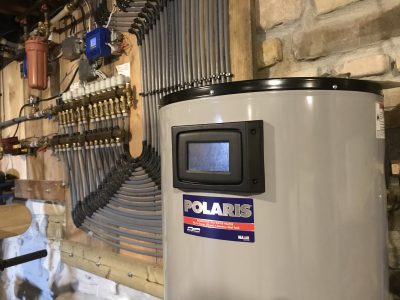
Hot water heating is getting more and more popular because it’s comfortable, quiet, steady and doesn’t kick up airborne dust. Both infloor heating and hot water radiators are sometimes called “hydronic heating” systems and both these options make people feel warmer at lower room temperatures than force air systems. These are some of the reasons hydronics are gaining in popularity. What you might not realize is how tank-style propane and natural gas heaters can be an ideal heat source for every kind of hot water heating system. Simplicity, versatility, costs savings and reliability are the benefits, but you need to get past some unfounded prejudices first. I don’t have anything against boilers, but you should know all the options before you decide.
Traditionally, hot water heating systems have been fired by some kind of boiler, and there are plenty of heating contractors who’ll tell you that tank-style heaters won’t work for heating. “A boiler’s the only way to go”, they say with confidence. The only problem with this opinion is that it’s wrong. The mistaken belief comes from attempts to use light duty water heaters for space heating applications in the past. The thing is, there’s nothing inherently wrong with having a tank of hot water supplying heat to warm a space. The issue comes down to whether or not a particular tank style heater is up to the job. As you’re deciding on heating systems to recommend to clients, understand that some tank-style heaters are perfectly capable of handling space heating situations. In fact, they’re actually built for this and they’re the ideal option for several technical reasons. As you look for a heating contractor to work on your projects, you’ll need to know how to talk intelligently about the situation if you want the benefits of a tank-style heater.
Hydronic Heating: The Benefits of Tank-Style Space Heating
Tank-style water heaters aren’t just good enough for space heating, they actually deliver four unique benefits that most boilers can’t match.
Hydronic Heating Benefit#1: Ideal water temperature
Boilers are often designed to put out 180ºF water in order to function properly. That’s way too hot for infloor heating and leads to less-than-safe radiator temperatures unless you also install a mixing valve to cut back output water temperatures. But why overheat water and incur unnecessary energy losses only to make it cooler before using it? Tank style water heaters, by contrast, are quite happy taking in water of any temperature and putting out 120ºF to 140ºF without the need for a mixing valve. This temperature range is perfect for hydronic space heating.
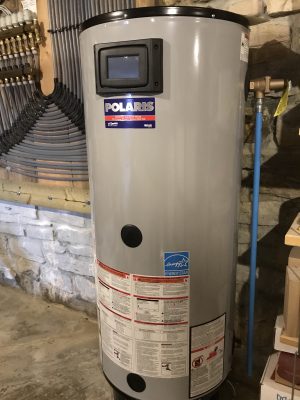
Hydronic Heating Benefit#2: Year-round usefulness
A tank style water heater can act as a space heater during winter, while also providing domestic hot water year-round without any added equipment. Some boilers can do this too, but not as simply or as maintenance-free as a tank-style heater.
Hydronic Heating Benefit#3: Simplicity
Maintenance of a tank-style heater is easy enough that most homeowners can do it themselves if they’ve got a simple, exchanger-free installation. Just connect a hose to the outlet at the bottom of the tank, then flip a valve to flush the sediment out of the tank once a year. If the system you install includes a flat plate heat exchanger for the space heating side of things flushing annually with vinegar is all that needs to happen.
Hydronic Heating Benefit#4: Compatible With Alternative Energy Sources
Tank-style water heaters are automatically and easily compatible with alternative heat energy technologies such as solar collectors or an outdoor wood boiler. Whatever alternative energy source your client has (or plans to have) it can preheat water before entering the tank, saving natural gas or propane as it does. You can’t do this with boilers.
Hydronic Heating: Choosing the Right Tank-Style Water Heater
There are a few different ways to configure a natural gas or propane tank-style heater as part of a hydronic heating system, but a dual-purpose approach for both space heating and domestic hot water makes the most sense. The main thing to understand is that you shouldn’t just allow water from these two systems to mix and leave it at that. One option is to keep domestic hot water completely separate from water that’s part of the heating system using a heat exchanger. The idea here is to prevent domestic water from getting contaminated by stale water that sits uncirculated in the heating system during the off-season. An added bonus of a heat exchanger is better heating system performance. Domestic water supplies usually run at 40 psi to 65 psi and that’s higher than ideal for hydronic heating and circ pumps. This is why the best system designs include a heat exchanger to transfer heat from the domestic hot water to the space heating water, without the two kinds of water mixing. Plate-style exchangers work best in this application, though they do need to be descaled every 6 months to 2 years by running vinegar through the exchanger with a transfer pump. This is the same maintenance required by any tankless water heater.
Another alternative is to go without a heat exchanger and install a timer and switch that automatically energizes the circulation pump on the space heating side. By circulating water through the heating system it never gets a chance to go stale. Not all jurisdictions allow this approach, and it means that your circulation pump operates at a higher-than-ideal pressure. But for small systems, an exchanger-free approach makes sense where permissible.
Click the images below to download detailed schematic drawings for connecting a tank-style water heater to drive hydronic heating systems. One schematic is for the simple system, and the other is for the more complex heat exchanger option.
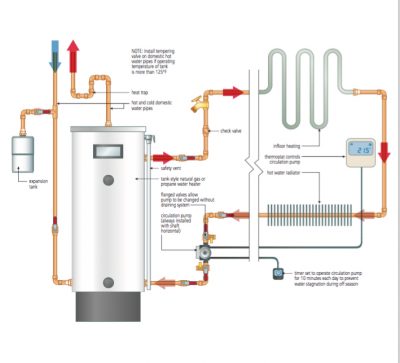
Regardless of your situation and plans, you need to begin by choosing a water heater that’s large enough to handle the maximum load of both space heating and domestic hot water. Today’s modulating heaters make this decision less critical than it used to be.
Click to download a schematic for installing a heat exchanger-style space heating systemModulation is a heater’s ability to automatically dial in more or less heat output depending on the load demanded. This means your client gets just as much efficiency if they need just a little heat or all that the heater can put out. Operating the heater at lower firing rates also means less thermal stress on the tank and increases the life of the water heater. Old-style non-modulating heaters, by contrast, operated either full blast or not at all, wasting energy when little heat is demanded. Modulating heaters in the 100,000 btu/hr to 150,000 btu/hr range are ideal for whole-house space heating plus domestic hot water production in most Canadian situations. The best boast verified efficiencies of more than 90%.
I used a heat exchanger approach for the tank-style, 150,000 btu/hr Polaris water heater I installed. It’s from North American company called A. O. Smith. This is a modulating unit with an efficiency rating of 95%, two sets of hot and cold outlets, and an exhaust and air intake system that requires only one hole through the house wall. It’s about as easy as it gets to use this model for space heating and domestic hot water. It’s also heavy duty and easily available across Canada..
Hydronic Heating: Tips for Layout and Installation
As you plan an installation, keep these tips in mind for most reliable operation:
Tip#1: Install circulation pumps at the lowest part of the system. This minimizes the chance trapped air will stop pumping action.
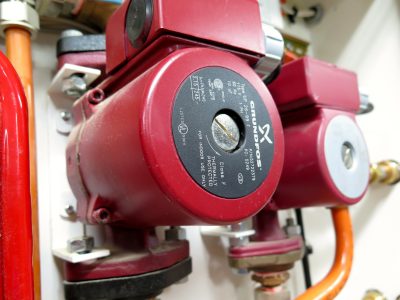
Tip#2: Install circulation pumps so the motor is oriented horizontally. Circ pumps are meant to run this way and will last longer than if the motor is installed vertically.
Tips#3: Install flush valves if you’re using a separate heat exchanger. The question isn’t “if” an exchanger like this will need descaling, but “when”. Even though most of the crud will build up on the domestic side of the exchanger, put flush valves on the heating side of the exchanger, just in case it needs flushing some day.
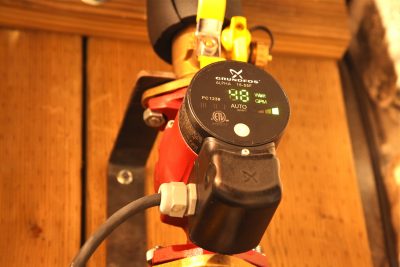
Tip#4: Choose “smart” circulator pumps. These automatically control current draw and water flow and use about 75% less energy than standard circ pumps. Smart pumps also include an LED screen so you can monitor flow rate and current draw.
Simpler can be better, and getting multiple uses from a single appliance is always good. These are the advantages of a tank-style water heater as part of a space heating installation. Just don’t let anyone tell you water heaters aren’t up to the job.
